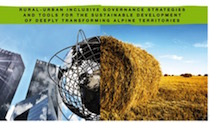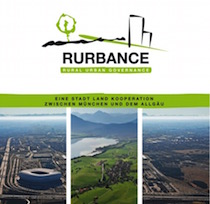Back to territory. Positions and forms of sustainability in Germany edited by Jörg Schröder and Maddalena Ferretti, with Claudia Di Girolamo
torna suRURBANCE - Rural-urban Cooperations and Governance Strategies. Jörg Schröder 
RURBANCE
as EU-project funded within the Alpine Space Programme, developed by 14 partners from 6 countries led by the Lombardy Region, is aiming at rural-urban inclusive governance strategies and tools for the sustainable development of deeply transforming Alpine territories. RURBANCE collects metropolises around and in the Alps (Milan, Munich, Zurich, Graz, Ljubljana, Grenoble, Turin, Verona) and rural areas connected to them as project-partnership and case-studies. In Germany the Institute of Regional Building and Urban Planning of Leibniz Universität Hannover as scientific partner for the project is cooperating with the regional development board of the Prealpine region Allgäu, and with the European Metropolitan Region Munich.
New Awareness for the Region
Region as field of action, based on common perception, re-adjusted values and scientific contribution to action in the last years has been re-emerged in academic, political and cultural positions. This increased awareness can be related to prevention of and adjustments to climate change, to aims of energy policies, to sustainability in general and connected debates about values; at the same time an actualized valutation and vision of territories has to be designed, as concrete spaces of action, with ongoing economic, demographic, ecological and social changes. RURBANCE aims at connecting functional and spatial factors in a coherent approach to the territory as natural and cultural creation. A certain focus of spatial development only on metropolitan cores, new centralitites as airports and science economy therefore may be complemented by a regional focus: not only questions of sustainablity and culture where to secure metropolitan supply of resources, materials, energy and food, but also regional added values in economy and culture, and regional identities are to be addressed. Therefore an actualized vision of rural-urban connections and cooperations, as formulated by RURBANCE, contributes to the development of metropolitan regions, shifting and enlarging the understanding and aims of these new territorial units, that are maybe established in academic debates, but actually in many regards disussed with their concrete realisation - organised in a bottom-up way as in the northern Alpine examples, or in an firsthand institutional way as in the Italian "metropolitan cities". At the same time a re-valuation of potentials of rural areas in economical and cultural sense are included in this approach. The following 5 paradigmatic threads are guiding the contribution of Leibniz Universität Hannover in the RURBANCE project:
Resilience
In order to re-gain balances of territorial development, the idea of resilience can be adapted to combined urban and rural development. Resilience in a first step addresses complex networks and overlayings of ecological systems, that are created in human-nature interaction. In a further step with this adaption the relations between built and natural spaces are focussed, both in urban and rural spheres. The evaluative and strategic dimension of resilience already can be noted in examples of phenoma and questions in this regard, as urban farming, new models of multifunctional agriculture, vision of the role of open spaces in the city, in forms of occupation of spaces and of social involvement, and of aesthetics. In many cases the understanding of territory between rural and urban populations, and the urban and rural nature of territories themselves, are diverse and not divided. Resilience as possible territorial paradigma therefore should comprehend also strenghts and challenges of settlement patterns, building culture and regional identities.
Re-Cycling
Both in urban and rural contexts the issue of re-use and re-cycling of existing build environment, of buildings, infrastructures, spaces of community and privacy already emerged important part of actual planning and architectural projects. Faced with imaginative, procedural and financial existing borders to trespass, a coherent vision of urban and rural recycling also lays ground for the implementation of energy goals in the territory: Policies in energy saving, efficiency, production, storage and networks have to address firsthand the existing building stock - in the Alps in general ca. 90% of the building stock has been erected before the introduction of energy standards. Renovation and investment are depending on regional and private possitbilities and motivations. As shown in the EU-project AlpHouse (www.alphouse.eu), for economic and sustainbility-related reasons not the focus on the adjustement of single buildings, but only a regional approach for energy strategies in concordance with territorial planning and building culture can reasonably reach overall energetic goals. This includes an enlarged set of tools for planning and realisation of energetic renovation of the building stock, that responds to the flexibility demanded by specific existing buildings - beyond questions regarding monuments, and city and landscape images and values.
Imbalances and Non-Simultaneities
As part of an actualized unterstanding of spatial realities - not only in the Alps - a differenciated view on growing and shrinking settlement structures has be achieved, in a spatial as well as in a time-oriented sense, for urban and rural areas. In the case studies of RURBANCE certainly overall observed patterns (shrinking south-Alpine regions, growing north-Alpine areas) have been confirmed; though in a closer view phenomena as suburbanisation, growing settlements along infrastructural axes, high-impact tourism spots, shrinking contexts, in many cases are overlapping, not only in micro-scales. Near and distant concentrations, as well as remote and sudden peripheries with all connected social and economic features, contribute to an increased complexity in the territorial setup - and call for actualizing analysis, conception and realization tools and strategies to imbalances and non-simultaneities, certainly a challenge since even urban and rural planning not yet share legal, procedural and funding backgrounds.
Rural-Urban Governance Models
Cooperation between rural and urban spheres in an enlarged vision - not only addressing suburban areas, but metropolitan cores, new and old centralities, peripheries - includes questions of decision-making and strategic action in the territory, and therefore can be connected to actual reserach and discussions about governance. For the approach of RURBANCE three main focusses have been identified: 1. the necessity to cross existing administrative and political borders of territorial bodies (or even national borders), in order to address common spatial potentials and challenges. Examples are the Interreg-Programs, the new metropolitan bodies as EMM Europäische Metropolregion München or Region Stuttgart (already institutionalized), or various intermunicipal initiatives and funding programms with that aim; 2. combinations of separated sectorial approaches to common territorial development question - regarding research, but mainly also administrative and policy backgrounds; and 3. open forms of communication, information, involvement of civil society organizations and citizens in general, of enterprises and research, already in early stages of decision-making and in the realization in the territory.
Territorial Vision
As one of the main topics of interest for rural-urban relations, the issues of landscape and agriculture in RURBANCE has been evaluated in different case studies and in a general view. With the formulation of the aim to use all natural resources in a coherent and sustainable way, research and implementation questions will be transferred beyond the project. The term "Green Infrastructures" in this context has to be related not only to conflicts between demands of nature protection, leisure for metropolitan populations, tourism, food supply, renewable energies, regional products, ecc. The very core of many of these conflicts is to be stated as a missing territorial vision in a regional scale.
For example in the German case study the "Prealpine Arc" between Salzburg and lake Bodensee is being drawn as macro-spatial context and visionary potential for common strategies and actions. The specific interest in the project - the comination of landscape and settlement/architecture related stategies - contributes to a cultural and economic re-valuation of urban and rural planning and architecture research and practise.
RURBANCE pilot areas and methodology
Around and in the Alps the chosen case study areas are Milan Metropolitan Region (Lombardy Region), City of Zurich and cantons of Schwyz, Uri and Ticino (City of Zurich), Bavarian Prealpine Arc (Leibniz Universität Hannover, Allgäu GmbH, in cooperation with European Metropolitan Region Munich), Graz and Surroundings (City of Graz), Ljubljana Urban Region (Slowenian Academy of Arts and Sciences), Verona and the Prealpine Valleys (Veneto Region), Turin, Ciriacese and Lanzo Valleys (Piedmont Region), and Grenoble Urban Region (Metropolitan Region Grenoble, Université Grenoble). Departing from the approach to consider urban aras and connected rural and mountain territories as unique territorial systems within regional, national and international networks, the methodological steps of the project have been designed as:
1. identifying pilot areas representing rural-urban interface situations,
2. analysis of ongoing development projects, policies' background and specific stakeholder constellation,
3. portraits of governance models, stakeholder involvement, setup of development discussion tabels,
4. design of shared territorial visions connected to pilot activities of development measures oriented towards the RURBANCE approach,
5. transfer and policies' readressing, contribution to a common alpine framework for development.
Further informations about RURBANCE can be found on www.rurbance.eu, the final conference of the project will be included in EXPO 2015 in Milan.
Jörg Schröder, architect and urban planner, is professor for regional building and urban planning at the faculty of architecture and landscape of Leibniz Universität Hannover.




